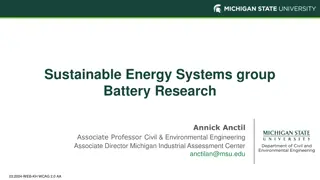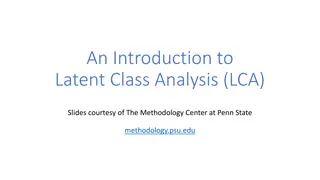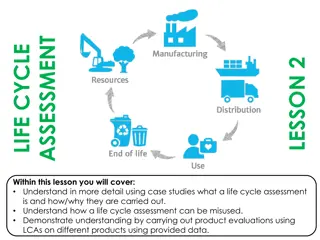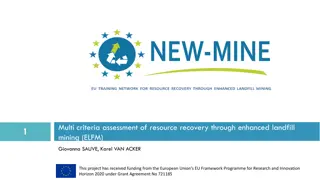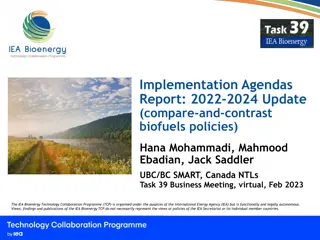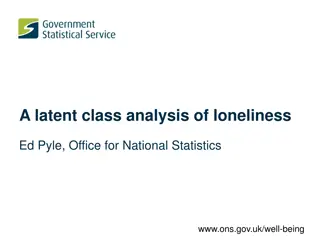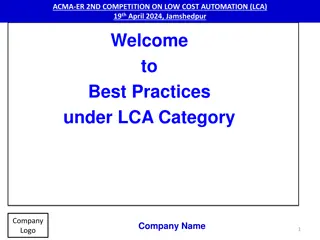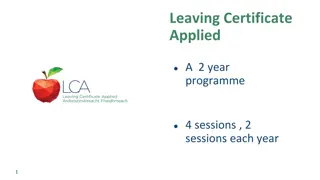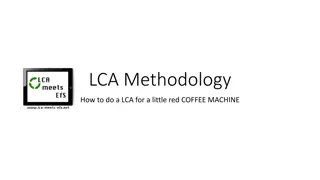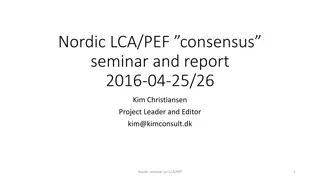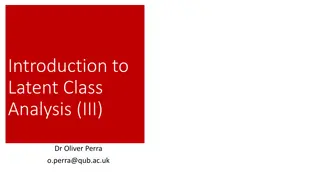
Least Common Ancestor and Range Min Queries Explained
Delve into the intricacies of two interrelated problems - Lowest Common Ancestors (LCA) and Range Min Queries (RMQ). Explore the LCA problem which involves finding the lowest common ancestor of two nodes in a tree, along with the RMQ problem which deals with identifying the index where an array attains its minimum value. Learn how to reduce LCA to RMQ through the concept of Euler tours in a rooted tree, enabling efficient query processing.
Download Presentation

Please find below an Image/Link to download the presentation.
The content on the website is provided AS IS for your information and personal use only. It may not be sold, licensed, or shared on other websites without obtaining consent from the author. If you encounter any issues during the download, it is possible that the publisher has removed the file from their server.
You are allowed to download the files provided on this website for personal or commercial use, subject to the condition that they are used lawfully. All files are the property of their respective owners.
The content on the website is provided AS IS for your information and personal use only. It may not be sold, licensed, or shared on other websites without obtaining consent from the author.
E N D
Presentation Transcript
Least Common Ancestor and Range Min Queries Used some slides prepared by Dvir Halevi
This lecture discusses two closely related problems: Lowest Common Ancestors (LCA) and Range Min Queries (RMQ)
The LCA Problem Given a tree T with nodes numbered 0, 1, 2, , n-1 we want to preprocess it so that we can answer the queries of the form: LCAT(I,j) : Compute the lowest common ancestor (LCA) of i and j in T. This is the unique node in the tree that is the ancestor of both i and j, and farthest from the root of the tree T. For example, LCAT(4,7) = 2, and LCAT(6,0) = 0.
The RMQ Problem Given an array A[0], A[1], , A[n-1] preprocess it so we can answer queries of the following form: RMQT(I,j) : Compute an index k in [i,j] where A attains its minimum value. i.e. A[k] = min{A[i], A[i+1], , A[j]}. We present two solutions to the RMQ problem Solution 1: Preprocessing time and space O(nlogn); query O(1) Solution 2: (Special case) Preprocessing time and space O(n); query O(1) In the special case of the RMQ problem each successive elements of A differs from the previous one by 1.
How to reduce LCA to RMQ An Euler tour of a rooted tree visits the vertices in a specific order <visit the root, visit the first subtree (recursively); then visit the root; visit the second subtree (recursively); visit the root; .>. It ends with a visit to the root. The Euler tour of this tree visits the node following order E: <0,1,0,2,3,4,3,2,5,6,5,7,5,2,0>
How to reduce LCA to RMQ The Euler tour of this tree visits the node following order E: <0,1,0,2,3,4,3,2,5,6,5,7,5,2,0> Lemma: Let T be a rooted tree, and let E be the Euler tour of T. Let i and j be the two indices into the Euler tour. Then LCAT(E[i],E[j]) occurs in the Euler tour between i and j.
How to reduce LCA to RMQ We construct three arrays. E: Euler tour L: depth of each node in the Euler tour array H: first occurrence array; H[i] is the index of the first occurrence of i in the Euler tour.
How to reduce LCA to RMQ We first build the RMQ data structure on L. LCAT[u,v] is going to be the shallowest (closest to the root) node of the range [H[u] .. H[v]] of the Euler tour. LCAT[u,v] = E[RMQL(H[u],H[v]). (assuming w.o.l.g H[u] H[v])
An <O(nlogn,O(1)> Solution to RMQ The algorithm described here is called sparse table method. The input is A[0, 1, 2, , n-1]. We compute a 2-D table M[0 n-1][0 ceiling(log2n)] M[i][j] = The index of a minimum value in A[i i + 2j-1]. This is the answer to the RMQ for a range of length 2jfrom i.
An <O(nlogn,O(1)> Solution to RMQ Here is a recurrence we can use to compute this table in O(1) time per entry. Note that M[i][j] will only be needed if i + 2j-1 n-1. M[i][j] = i if j = 0; else If j > 0, let m1= M[i][j-1] and m2= M[i + 2j-1][j-1]. if A[m1] A[m2], M[i,j] = m1 else M[i,j] = m2. i + 2j-1 i + 2j-1 2j-1 2j-1 i i + 2j-1-1 m2 m1 This gives us the solution to a RMQ when the length of the query is a power of 2. Preprocessing cost O(nlogn); space = O(nlogn) Query time is O(1).
An <O(nlogn,O(1)> Solution to RMQ For arbitrary lengths we can compute the answer with just two look ups. RMQA(i,j) Let k = floor(log2(j-i+1). Let m1 = M[i][k]; m2 = M[j-2k+1][k] If A[m1] A[m2] then output m1 else output m2. Th solution overall is O(nlogn) space and time, and query cost is O(1).
Faster RMQ Use a table-lookup technique to precompute answers on small subarrays, thus removing the log factor from the preprocessing. Partition A into blocks of size . log n 2 log n n 2 A 2n blocks ... ... ... ... ... log n log log log n n n 2 2 2 12
Faster RMQ 2 n A [1,.., A [i] is the minimum element in the i-th block of A. ] log n 2 n ] B [i] is the position (index) in which value A [i] occurs. B[1,.., log n A 2n A [0] A [i] A [2n/logn] blocks ... ... ... ... ... log n log n 2 ... B[i] 13 B[0] B[2n/logn]
Example: n=16 A[] : 8 0 1 2 3 4 5 6 7 9 10 11 12 13 14 15 10 25 22 7 34 9 2 26 33 12 24 43 5 11 19 27 2n blocks 10 25 = 8 22 7 34 9 log n B[] : 0 1 2 A [] : 0 1 2 0 3 5 10 7 9 14
Faster RMQ Recall RMQ queries return the position of the minimum. LCA to RMQ reduction uses the position of the minimum, rather than the minimum itself. Use array B to keep track of where minimas in A came from. 15
Faster RMQ Preprocess A for RMQ using ST algorithm. ST s preprocessing time O(nlogn). 2 n A s size log n 2 2 n n = log( ) ( ) O n ST s preprocessing on A : ST(A ) = log log n n ( ), (1) O n O 16
Faster RMQ Having preprocessed A for RMQ, how to answer RMQ(i,j) queries on A? i and j might be in the same block -> preprocess every block. i < j on different blocks, answer the query as follows: 1. 2. 3. Compute minima from i to end of its block. Compute minima of all blocks in between i s and j s blocks. Compute minima from the beginning of j s block to j. Return the index of the minimum of these 3 values. 17
Faster RMQ i < j on different blocks, answer the query as follows: 1. Compute minima from i to end of its block. 2. Compute minima of all blocks in between i s and j s blocks. 3. Compute minima from the beginning of j s block to j. 2 Takes O(1) time by RMQ on A . 1 & 3 Have to answer in-block RMQ queries We need in-block queries whether i and j are in the same block or not. 18
Faster RMQ First Attempt: preprocess every block. log = log n n Per block : log (log loglog ) n O n 2 2 All blocks log n 2 n ( loglog ) O n n Second attempt: recall the LCA to RMQ reduction RMQ was performed on array L. What can we use to our advantage? 1 restriction 19
Faster RMQ Observation: Let two arrays X & Y such that Then , i j RMQ ( , ) = Y[i] C + X[i] i = ( , ) i j RMQ i j X Y A[0] A[1] A[2] A[3] A[4]A[5] A[6] A[7] A[8] A[9] 3 4 5 6 5 4 5 6 5 4 B[3] B[4]B[5] B[6] B[7] B[8] B[0] B[1] B[2] B[9] 0 1 2 3 2 1 2 3 2 1 +1 +1 +1 -1 -1 +1 +1 -1 -1 = log n 1 2 2 ( ) O n There are normalized blocks. ( ) O n 20
Faster RMQ Preprocess: Create tables of size queries. Overall . 2 ( ) (log O n = ) O n O ) n to answer all in block ( 2 log ( ) O n n For each block in A compute which normalized block table it should use ( ) O n ( ) O n Preprocess A using ST - Query: Query on A Query on in-blocks (1) O (1) O ( ), (1) O n O Overall RMQ complexity - 21


